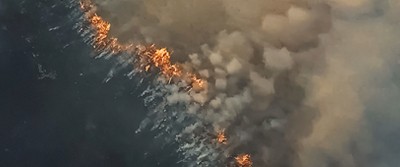Australian Wildfires Put Hundreds of Species at Risk

By Moira Bell
Australia is one of the most biodiverse countries in the world. Its varied ecosystems that range from lush tropical rainforests to sparse deserts are home to 570,000 different species, accounting for more than 5 percent of the world’s plants and animals.
Wildfires that blazed through the continent from September 2019 to February 2020 have put the populations of hundreds of these species at risk.
Assessing the Damage
Leveraging previous calculations that were used to determine the loss of animals from land-clearing practices, scientists estimate 100 billion animals were lost in these wildfires. This number, which does not account for bats, frogs, or invertebrates, is likely to be much higher and could be closer to the trillions, according to Mike Lee, biologist at the South Australian Museum in Adelaide.
The glossy black cockatoo, native to Australia’s Kangaroo Island, was at one time considered critically endangered with extinction. A recovery program that began in 1995 was responsible for increasing its numbers in the wild from 150 to 400, allowing scientists to change its status to endangered. Now, with most of its habitat destroyed, food sources scarce, and its numbers unknown, a much more hopeless narrative is unfolding, and the glossy black cockatoo is not the only victim.
Among the lost could be the Richmond birdwing butterfly, many species of peacock spiders, and the dunnart, a shrew-sized marsupial. Before the wildfires, there were only 500 known dunnarts in the wild. All 13 sites inhabited by dunnarts were burned by the fires.
It’s also estimated that three in every 10 koalas that were living in the eastern state of New South Wales died in the fires. This was the only population that hadn’t been affected by a disease spreading through koalas.
Aftereffects
Heavy rains are a welcome relief from the wildfires, but they pose a new set of issues for animals down under. The water will wash soot and ash into rivers, lakes, and oceans, which could harm freshwater and marine species.
The effects of these wildfires are likely to be felt for years to come. Even if animals managed to survive, their habitats and food sources may be gone or, at the very least, scarce. Many endangered species have adapted to a very specific ecosystem to survive, making it improbable that their exact conditions for life on Earth have been preserved.
Although the wildfires have stopped, the devastation to Australia’s stunning biodiversity will continue to reveal itself over time.
Discussion Questions
- Find three animals that are unique to Australia. How would the loss of these rare species affect their habitats, prey, food sources, and humans?
- Research what can we do as a society to prepare for more frequent and extreme weather conditions such as wildfires and storms.
Vocabulary
- Biodiversity
- Ecosystems
- Conservation
- Habitat